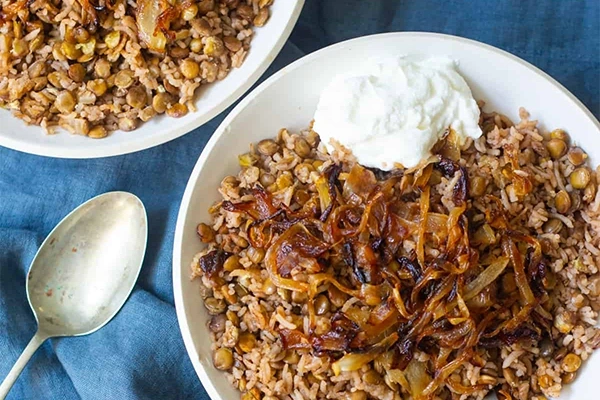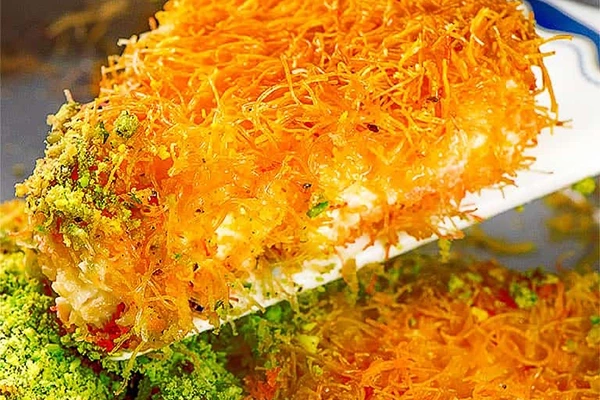The holy month of Ramadan, the month of fasting and worship, is a time when Muslims pay special attention to healthy and nutritious food. **Food for Ramadan** should not only be delicious, but should also provide the necessary energy for long days of fasting. In this article, we will examine the types of **Ramadan food** and provide useful instructions and ideas.

All kinds of Ramadan food dishes
Food for Ramadan can be divided into several categories:
1. iftar Ramadan food: This meal is very important to break the fast. It usually starts with dates and water and then continues with light and nutritious foods.
2. Breakfast foods: this meal should be rich in protein and complex carbohydrates to provide the necessary energy for the day.
3. Main dishes: the main meals that are usually eaten after breaking the fast.
4. Desserts and drinks: Ramadan sweets and drinks that provide instant energy.
Arabic food recipes for Ramadan
Some of the most popular Arabic food recipes for Ramadan are:
1. Harira: rich and nutritious Moroccan soup
2. Fattoosh: Arabic salad with toasted pita bread
3. Maqlouba: rice with meat and vegetables
4. Lentil rice: simple and nutritious food
5. Konafeh: sweet and cheesy dessert
Food ideas for Ramadan
1. For Iftar: Start with dates and water, then a light soup like lentil soup, followed by a light main course like grilled chicken with vegetables.
2. For breakfast: omelette with vegetables, wholemeal bread, low-fat cheese and fruit.
3. The main dish: meatballs, hairballs, or fish with rice and salad.
4. Dessert: yellow shale, zolbia and okra, or fresh fruits.
The importance of proper nutrition in Ramadan
Proper nutrition during the holy month of Ramadan plays a vital role in maintaining the health, energy and concentration of fasting people. Choosing the right **food for Ramadan** can have a significant impact on the quality of fasting and worship.
Ramadan food should be chosen in such a way that it not only meets the nutritional needs of the body, but also provides the necessary energy for daily activities. Ramadan food dishes should be rich in protein, fiber, vitamins and minerals so that the body can tolerate the long hours of fasting well.
Iftar Ramadan food is of special importance because it is the first meal after a day of fasting. This meal should be light and at the same time nutritious so as not to upset the stomach and provide the body with the necessary substances. Starting Iftar with dates and water, followed by a light soup, can be a good option.
For suhoor, it is essential to use the best food to eat during Ramadan. This meal should include complex carbohydrates, lean proteins, and fiber to provide sustained energy throughout the day. Foods like oatmeal, eggs, low-fat dairy, and fruits can be good choices.
Getting to know the of Arabic food recipes for ramadan dishes for can give a good variety to the fasting people’s table. Foods such as harira, fattoush, and maqlouba are not only delicious, but also have high nutritional value.
Paying attention to proper nutrition in Ramadan, in addition to maintaining physical health, helps to improve concentration in worship and benefit more from the blessings of this holy month. By following the principles of proper nutrition and choosing food wisely, you can spend the month of Ramadan with joy and full health.
The best Ramadan food
Choosing food for Ramadan plays an important role in maintaining the health and energy of fasting people. The best food to eat during Ramadan should be nutritious, balanced, and full of nutrients the body needs. In the following, we introduce a list of the best Ramadan food dishes:
1. Protein sources
– Low-fat chicken and fish: this Ramadan food is rich in protein and helps maintain muscle mass.
– Legumes: Lentils, beans and peas are excellent sources of vegetable protein and are used in many Arabic food recipes for Ramadan.
– Eggs: an excellent source of protein that can be included in the breakfast meal iftar Ramadan food.
2. Complex carbohydrates
– Whole grains: Whole grain bread, brown rice and rolled oats provide stable energy for the whole day.
– Sweet potato: it is rich in vitamins and fiber.
3. Fruits and vegetables
– Dates: one of the best Ramadan food dishes, which is rich in natural sugar and fiber.
– Banana: rich in potassium and a good source of quick energy.
– Green leafy vegetables: Spinach, lettuce and kale are rich in vitamins and minerals.
4. Low-fat dairy products
– Yogurt: a good source of protein and probiotics that is used in many Arabic food recipes for Ramadan.
– Low-fat cheese: a good source of calcium and protein.
5. Nuts and seeds H3
– Almonds, walnuts and pumpkin seeds: they are rich in healthy fatty acids and protein.

6. Beverages
– Water: the most important drink to keep the body hydrated.
– Milk: a good source of protein and calcium.
– Natural fruit juices: to supply vitamins and minerals.
7. Traditional foods
– Hurira: A popular iftar Ramadan food dish that is rich in nutrients.
– Fattoosh: Arabic salad which is a good source of fiber and vitamins.
To fully benefit from this food for Ramadan, it is recommended to plan balanced and varied meals. A combination of protein, complex carbohydrates, fruits and vegetables in each meal can provide sustained energy and nutrients necessary for a healthy fast. Remember that drinking enough water between Iftar and Suhoor is very important. Also, avoiding very salty, sweet or fatty foods can help maintain health during Ramadan.
Conclusion
The holy month of Ramadan is a valuable opportunity to strengthen the soul and body, and choosing the right **food for Ramadan** plays a vital role in this direction. As we reviewed in this article, “Ramadan food dishes should be diverse, nutritious and appropriate to the needs of the body in fasting conditions. From iftar Ramadan food to Suhoor meal, each has its own importance. Starting Iftar with dates and water, consuming light soups and protein foods afterwards, and choosing **the best food to eat during Ramadan** such as legumes, whole grains and fruits for Suhoor, are all effective in maintaining the health and energy of fasting people. With the of Arabic food recipes for Ramadan, it not only gives a good variety to the table, but also introduces us to the rich food traditions of the Islamic world. Foods such as harira, fattoosh and maqlouba, in addition to their pleasant taste, also have a high nutritional value. Remember that the purpose of choosing food for ramadan is not only to fill the stomach, but also to provide energy and nutrients necessary for performing worship and daily duties. Balance in food consumption, avoiding overeating, and drinking enough water between iftar and dawn are the main keys to a healthy fasting.